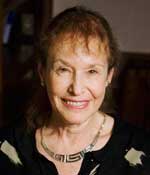Lillian Hoddeson Wins 2012 Pais Prize
By Elizabeth Garber and Michael Riordan

Lillian Hoddeson of the University of Illinois has been selected to receive the 2012 Abraham Pais Prize for the History of Physics to recognize her many contributions to the discipline. In its recommendation the Pais Prize Committee cited Hoddeson "for her leadership and contributions to writing the history of twentieth-century physics, her pioneering studies of American research laboratories— particularly Bell Labs, Los Alamos and Fermilab—and her perceptive scientific biography of John Bardeen."
After earning her Ph.D. in physics from Columbia University, Hoddeson did early historical studies on the beginnings of industrial research at Bell Telephone Laboratories, which led to her work on the development of solid-state physics and the invention of the point-contact transistor. With Spencer Weart she organized the American section of the International Project on the History of Solid State Physics. This research led eventually to publication of Out of the Crystal Maze: Chapters from the History of Solid State Physics (Oxford, 1992)—an invaluable resource on the history of solid-state physics for which she served as lead editor.
With Michael Riordan, Hoddeson published Crystal Fire: The Birth of the Information Age (Norton, 1997), which is widely regarded as the definitive history of the invention and development of the transistor. Its award-winning PBS-TV adaptation "Transistorized!" has had a broad impact on general audiences.
Hoddeson has also worked on the history of the development of the atomic bomb. While researching this subject, she realized that Los Alamos was in danger of losing its wartime documents and proposed that the Laboratory create an archive and a history project. She directed a team of scholars, which included Paul Henrickson, Roger Meade and Catherine Westfall, and used both classified and unclassified documents to publish Critical Assembly: A Technical History of Los Alamos during the Oppenheimer Years, 1943–1945 (Cambridge, 1993). This monograph is considered the definitive technical work and the standard reference on the history of the building of the atomic bomb. It was widely acclaimed by Manhattan Project participants, including Hans Bethe, Robert Bacher and Norman Ramsey.
At Fermilab, Hoddeson established an archive and a history program focused on particle accelerators and high-energy physics. With Laurie Brown, and later with Max Dresden and Riordan, she organized a series of three international symposia on the history of particle physics, which resulted in The Birth of Particle Physics (Cambridge, 1983), Pions to Quarks (1989), and The Rise of the Standard Model (1997). All of them books are indispensable resources on the history of particle physics.
Hoddeson’s most recent historical work, Fermilab: The Frontier, Physics and Megascience (Chicago, 2008), co-authored with Adrienne Kolb and Westfall, reflects some 30 years of research and is in many ways one of her most important works. Its narrative involves two novel, intertwined themes—the emergence and evolution of big science at Fermilab, and how the imagery of the American frontier was imaginatively invoked by Robert Wilson and Leon Lederman in building and directing the laboratory. This book is a sophisticated analysis of "megascience" and a study of the narrowing focus of big science following the budgetary tightening that began around 1970. Peter Galison observed that its authors have done "a superb job of following the turbulent confluence of science policy and created a major study of broad interest to anyone who wants to understand what large-scale research looks like in the real world." Gino Segre described the book as "masterful in being both a major scholarly contribution to the history of physics and a riveting read."
Hoddeson has also contributed importantly to the writing of scientific biography by virtue of her numerous, extensive interviews with leading scientists, and by writing with Vicki Daitch the biography of John Bardeen, one of the outstanding 20th century physicists. True Genius: The Life and Science of John Bardeen (Joseph Henry, 2002) was recognized by the Times Higher Education Supplement as one of the best non-fiction books of 2002 and named a Silver Winner in Foreward Magazine’s Book of the Year awards.
Hoddeson has conducted over 500 oral-history interviews. Her work instructing students and colleagues in the art of interviewing, especially through a graduate seminar in the University of Illinois History Department, has extended the work of Charles Weiner and Weart in new directions and to new audiences. She has introduced hundreds of students to the methods and theory of oral history in other fields such as sociology, policy studies, education, and anthropology. Her publications in this area are widely circulated, translated and cited, not just by historians of science and physicists but by scholars in cognitive psychology and education. Hoddeson’s current work in progress includes a biography of the prolific inventor Stanford Ovshinsky and a monograph on the theory and methodology of interviewing that takes into account what is presently known about the psychology of human memory.
Lillian Hoddeson richly deserves the recognition of the 2012 Abraham Pais Prize for her impressive achievements in the history of physics.
The articles in this issue represent the views of their authors and are not necessarily those of the Forum or APS.
